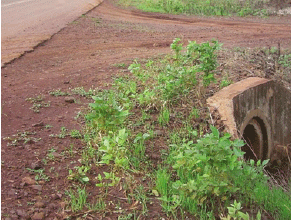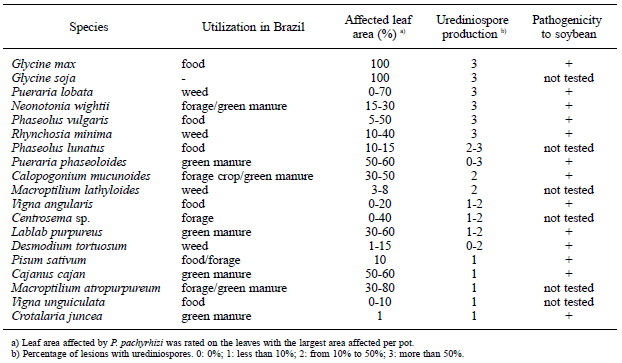Hosts of Phakopsora pachyrhizi, a causal organism of soybean rust, in South America
Description
Soybean is the most important agricultural product in Brazil, Paraguay, and Argentina. Although soybean rust was an endemic disease only in Asia and Australia until the 1980s, its presence was documented in Hawaii in 1994 and then in Paraguay in 2001, its first appearance on the American continent. Since then it has spread to the major soybean production areas in South America. It causes premature defoliation and yield loss.
The disease pathogen, Phakopsora pachyrhizi, is an obligate parasite that needs living host tissue to survive. If living hosts are eliminated from fields, the population size of P. pachyrhizi diminishes and the onset of soybean rust is considerably delayed. There is little knowledge of the host range of the pathogen in South America because it is an emerging disease. More than one hundred leguminous species are reported to be hosts of P. pachyrhizi. Therefore, to be able to eliminate these hosts, it is important to know which plants play a significant role as infection sources in the field.
We examined the host range of P. pachyrhizi and compared difference in susceptibility to the pathogen among leguminous plants. Leguminous species were selected from table crops, forage crops, green manure, and weeds around soybean fields in Brazil. Of the 31 species examined, P. pachyrhizi produced lesions with uredinia in 19 species (Table 1). The susceptibility varied greatly among hosts. Many lesions, uredinia, and urenidiospores were produced on soybean (Glycine max), wild soybean (Glycine soja), and kudzu (Pueraria lobata). The second most numerous lesions with uredinia were produced on common bean (Phaseolus vulgaris), lima bean (Phaseolus lunatus), perennial soybean (Neonotonia wightii), and least snout-bean (Rhynchosia minima). Many lesions were also produced on pigeon pea (Cajanus cajan), but defoliation of the infected leaves was too rapid to allow production of urenidiospores. The remaining hosts did not produce many lesions with uredinia.
TDuring June to September, P. pachyrhizi was found on volunteer soybean, kudzu, and perennial soybean in southern Brazil and southern Paraguay (Fig. 1), and on soybean irrigated with pivot center systems in the Central West region of Brazil. In particular, soybean and kudzu are likely to play an important role as infection sources of soybean rust to soybean fields.
Figure, table
-
Fig. 1. Volunteer soybeans infected with Phakopsora pachyrhizi along the roadside. -
Table 1. Production of lesions and urediniospores of Phakopsora pachyrhizi on leguminous species.
- Affiliation
-
Japan International Research Center for Agricultural Sciences Biological Resources Division
- Classification
-
Technical A
- Term of research
-
FY2006(FY2006~2010)
- Responsible researcher
-
KATO Masayasu ( Biological Resources Division )
YORINORI Jose Tadashi ( EMBRAPA Soybean )
PAIVA Wilfrido Morel ( Centro Regional de Investigación Agrícola )
Yamaoka Yuuichi ( University of Tsukuba )
KAKEN Researcher No.: 00220236 - ほか
- Publication, etc.
-
Kato, M., Morel Paiva, W., Yamaoka,Y. and Yorinori, J.T. (2005). Situation of soybean rust (Phakopsora pachyrhizi) during winter of 2004 in southern Brazil and Paraguay. 13th Congreso Latinoamericano de Fitopatologia - 3th Taller de la Asociacion Argentina de Fitopatologos. Libro de Resumenes. 360.
Kato, M. and Yorinori, J.T. (2005). Variation in productivity of lesions, uredinia and urediniospores of Phakopsora pachyrhizi among leguminous plants. Proceedings of the National Soybean Rust Symposium.
- Japanese PDF
-
2006_seikajouhou_A4_ja_Part7.pdf493.26 KB


